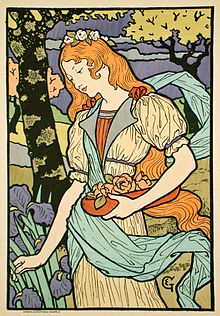Eugène Grasset
This article needs additional citations for verification. (April 2024) |
Eugène Grasset | |
|---|---|
Art nouveau |

Eugène Samuel Grasset (25 May 1845 – 23 October 1917) was a Swiss
Biography
Grasset was born in
Between 1869 and 1870, Grasset worked as a theater painter and sculptor in Lausanne. Here he met Viollet le Duc, whose reflection on the Middle Ages and the method advocating the link between form, function and material came to permeate Grasset's work.[4] In 1871 he moved to Paris and he started to design furniture, wallpapers, fabrics, and tapestries as well as ceramics and jewelry. He created architectural elements of woodwork that were integrated into buildings. His fine art decorative pieces were crafted from ivory, gold, and other precious materials in unique combinations, and his creations are considered a cornerstone of Art Nouveau motifs and patterns.
In 1877 Eugène Grasset turned to graphic design, producing income-generating products such as postcards and eventually postage stamps for both France and Switzerland. It was
With the growing popularity of French posters in the United States, Grasset was soon contacted by several American companies. In the 1880s, he did his first American commission and more success led to his cover design for the 1892 Christmas issue of

Grasset taught design at the École Guérin from 1890 to 1903, at the École d’Art graphique in the rue Madame from 1903 to 1904, at the Académie de la Grande Chaumière from 1904 to 1913, and at the École Estienne in Paris. Grasset had freely adapted the alphabet of Nicolas Jenson (1471) with the intention of using it to print a book on his own method for ornamental composition, inspired by the courses he gave to the Guérin school. Georges Peignot acquired Grasset's alphabet and obtained an official patent on 7 October 1897 for the typeface under the name, "Grasset". He then gave Henri Parmentier, the workshop's punchcutter, the mission to engrave it.
In 1896 he published a dissertation on the use of plants in designs,
At the
Grasset died in 1917 in
-
Grasset poster, Drei Frauen und drei Wölfe, c. 1892.
-
La Vitrioleuse ("The Acid Thrower"), 1894, lithograph with hand-stencilled colours, for L'Estampe originale
-
Sarah Bernhardt as Jeanne d'Arc
-
La danse, Issue no. 59 of Paris illustré, published 1887.
-
A La Place Clichy by Grasset, c. 1891
Exhibitions
- Cantonal Museum of Fine Arts, Lausanne, 2011.
See also
- Georges Peignot made the typeface, Grasset, at his foundry
- Grasset typeface
- Samantha Littlefield Huntley, one of his students
Citations
- ^ Murray Robertson, p. 19
- ^ Murray Robertson, p. 103
- ^ Jean-François Luneau, p. 359
- ^ Murray Robertson, Anne (2016). Eugene Grasset (in French). Swiss Institute of Art Research.
- ^ "Eugene Grasset". Art Directory.
- ^ Plants and Their Application to Ornament (1896), Public Domain Review, accessed 2019.05.01
General and cited references
- Anne Murray Robertson (1998). Eugène Grasset: une certaine image de la femme : [exposition, Fondation Neumann, Gingins, 17 septembre 1998 - 31 janvier 1999]. Skira. ISBN 978-88-8118-409-5.
- Jean-François Luneau (2006). Félix Gaudin: peintre-verrier et mosaïste, 1851-1930. Presses Univ Blaise Pascal. ISBN 978-2-84516-284-6.
External links
- Publications by and about Eugène Grasset in the catalogue Helveticat of the Swiss National Library





